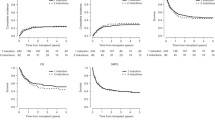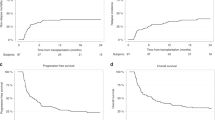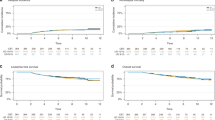Abstract
To assess the outcome of unrelated umbilical cord blood transplantation (UCBT), 141 children with AML who underwent UCBT (39 in first CR (CR1), 33 in CR2, 4 in CR3 and 65 at more advanced stages (not in CR)) were analyzed in a retrospective multicenter study in Japan. Short-term MTX was used for prophylaxis of acute GVHD in 80 cases (57%). The cumulative incidences of neutrophil recovery, platelet recovery and acute GVHD (grades 2–4) were 78.7, 62.4 and 40.1%, respectively, and the 100-day transplantation-related mortality (TRM) was 10.8%. Multivariate analysis showed that an infused CD34+ cell dose of 1.35 × 105 cells per kg or more was associated with favorable neutrophil and platelet recovery, and that short-term MTX was associated with a lower 100-day TRM. The 6-year relapse rate was 38.8% and was associated with disease status. Six-year overall survival was 45.8% (70.4±8.3% in CR1, 59.3±11.3% in CR2, 75.5±21% in CR3 and 20.6±6.2% for children with non-CR). We conclude that the results of UCBT are particularly promising for children with a karyotype suggesting a poor prognosis, and for those who receive transplants in CR2 and CR3 after an early relapse.
This is a preview of subscription content, access via your institution
Access options
Subscribe to this journal
Receive 12 print issues and online access
$259.00 per year
only $21.58 per issue
Buy this article
- Purchase on Springer Link
- Instant access to full article PDF
Prices may be subject to local taxes which are calculated during checkout



Similar content being viewed by others
References
Gibson BES, Wheatley K, Hann IM, Stevens RF, Webb D, Hills RK, et al., De Graaf SSN and Harrison CJ for the United Kingdom. Childhood Leukaemia Working Party, and the Dutch Childhood Oncology Group. Treatment strategy and long-term results in paediatric patients treated in consecutive UK AML trials. Leukemia 2005; 19: 2130–2138.
Creutzig U, Zimmermann M, Ritter J, Reinhardt D, Hermann J, Henze G et al. Treatment strategies and long-term results in paediatric patients treated in four consecutive AML-BFM trials. Leukemia 2005; 19: 2030–2042.
Smith FO, Alonzo TA, Gerbing RB, Woods WG, Arceci RJ . Long-term results of children with acute myeloid leukemia: a report of three consecutive Phase III trials by the Children's Cancer Group: CCG 251, CCG 213 and CCG 2891. Leukemia 2005; 19: 2054–2062.
Ravindranath Y, Chang M, Steuber CP, Becton D, Dahl G, Civin C et al. Pediatric Oncology Group (POG) studies of acute myeloid leukemia (AML): a review of four consecutive childhood AML trials conducted between 1981 and 2000. Leukemia 2005; 19: 2101–2116.
Aladjidi N, Auvrignon A, Leblanc T, Perel Y, Bénard A, Bordigoni P et al. Outcome in children with relapsed acute myeloid leukemia after initial treatment with the French Leucemie Aique Myeloide Enfant (LAME) 89/91 protocol of the French Society of Pediatric Hematology and Immunology. J Clin Oncol 2003; 21: 4377–4385.
Abrahamsson J, Clausen N, Gustafsson G, Hovi L, Jonmundsson G, Zeller B et al. Nordic Society for Paediatric Haematology and Oncology (NOPHO). Improved outcome after relapse in children with acute myeloid leukaemia. Br J Haematol 2007; 136: 229–236.
Johnston DL, Alonzo TA, Gerbing RB, Lange BJ, Woods WG . Risk factors and therapy for isolated central nervous system relapse of pediatric acute myeloid leukemia. J Clin Oncol 2005; 23: 9172–9178.
Rubnitz JE, Razzouk BI, Lensing S, Pounds S, Pui CH, Ribeiro RC . Prognostic factors and outcome of recurrence in childhood acute myeloid leukemia. Cancer 2007; 109: 157–163.
Balduzzi A, Gooley T, Anasetti C, Sanders JE, Martin PJ, Petersdorf EW et al. Unrelated donor marrow transplantation in children. Blood 1995; 86: 3247–3256.
Sierra J, Storer B, Hansen JA, Martin PJ, Petersdorf EW, Woolfrey A et al. Unrelated donor marrow transplantation for acute myeloid leukemia: an update of the Seattle experience. Bone Marrow Transplant 2000; 26: 397–404.
Marks DI, Bird JM, Vettenranta K, Hunt L, Green A, Cornish JM et al. T cell-depleted unrelated donor bone marrow transplantation for acute myeloid leukemia. Biol Blood Marrow Transplant 2000; 6: 646–653.
Kurtzberg J, Laughlin M, Graham ML, Smith C, Olson JF, Halperin EC et al. Placental blood as a source of hematopoietic stem cells for transplantation in unrelated recipients. N Engl J Med 1996; 335: 157–166.
Wagner JE, Rosenthal J, Sweetman R, Shu XO, Davies SM, Ramsay NK et al. Successful transplantation of HLA-matched and HLA-mismatched umbilical cord blood from unrelated donors: analysis of engraftment and acute graft-versus-host-disease. Blood 1996; 88: 795–802.
Gluckman E, Rocha V, Boyer-Chammard A, Locatelli F, Arcese W, Pasquini R et al. Outcome of cord-blood transplantation from related and unrelated donors. Eurocord Transplant Group and the European Blood and Marrow Transplantation Group. N Engl J Med 1997; 337: 373–381.
Rubinstein P, Carrier C, Scaradavou A, Kurtzberg J, Adamson J, Migliaccio AR et al. Outcome among 562 recipients of placental blood transplants from unrelated donors. N Engl J Med 1998; 339: 1565–1577.
Rocha V, Cornish J, Sievers EL, Filipovich A, Locatelli F, Peters C et al. Comparison of outcome of unrelated bone marrow and umbilical cord blood transplants in children with acute leukemia. Blood 2001; 97: 2962–2971.
Ohnuma K, Isoyama K, Ikuta K, Toyoda Y, Nakamura J, Nakajima F et al. Cord blood transplantation from HLA-mismatched unrelated donors as a treatment for children with haematological malignancies. Br J Haematol 2001; 112: 981–987.
Isoyama K, Ohnuma K, Kato K, Takahashi TA, Kai S, Kato S, et al., Japanese Cord Blood Bank Network. Cord blood transplantation from unrelated donors: a preliminary report from the Japanese Cord Blood Bank Network. Leuk Lymphoma 2003; 44: 429–438.
Michel G, Rocha V, Chevret S, Arcese W, Chan KW, Filipovich A et al. Unrelated cord blood transplantation for childhood acute myeloid leukemia: a Eurocord Group analysis. Blood 2003; 102: 4290–4297.
Gluckman E, Rocha V, Arcese W, Michel G, Sanz G, Chan KW, et al., Eurocord Group. Factors associated with outcomes of unrelated cord blood transplant: guidelines for donor choice. Exp Hematol 2004; 32: 397–407.
Wall DA, Carter SL, Kernan NA, Kapoor N, Kamani NR, Brochstein JA, et al., COBLT Steering Committee. Busulfan/melphalan/antithymocyte globulin followed by unrelated donor cord blood transplantation for treatment of infant leukemia and leukemia in young children: the Cord Blood Transplantation study (COBLT) experience. Biol Blood Marrow Transplant 2005; 11: 637–646.
Sobocinski KA, Horowitz MM, Rowlings PA, Zhang MJ, Nugent ML, Passweg JR et al. Bone marrow transplantation—1994: a report from the International Bone Marrow Transplant Registry and the North American Autologous Bone Marrow Transplant Registry. J Hematother 1994; 3: 95–102.
Moretti S, Dabusti M, Castagnari B, Tieghi A, Ferrari L, Campioni D et al. Comparison of single and dual platform methodologies for the estimation of CD34+ hematopoietic progenitor cells: correlation with colony assay. Int J Biol Markers. 2002; 17: 259–267.
Glucksberg H, Storb R, Fefer A, Buckner CD, Neiman PE, Clift RA et al. Clinical manifestations of graft-versus-host disease in human recipients of marrow from HL-A-matched sibling donors. Transplantation 1974; 18: 295–304.
Storb R, Prentice RL, Sullivan KM, Shulman HM, Deeg HJ, Doney KC et al. Predictive factors in chronic graft-versus-host disease in patients with aplastic anemia treated by marrow transplantation from HLA-identical siblings. Ann Intern Med 1983; 98: 461–466.
Gooley TA, Leisenring W, Crowley J, Storer BE . Estimation of failure probabilities in the presence of competing risks: new representations of old estimators. Stat Med 1999; 18: 695–706.
Fine JP, Gray RJ . A proportional hazards model for the sub distribution of a competing risk. J Am Stat Assoc 1999; 94: 496–509.
Grimwade D, Walker H, Oliver F, Wheatley K, Harrison C, Harrison G et al. The importance of diagnostic cytogenetics on outcome in AML: analysis of 1,612 patients entered into the MRC AML 10 trial. The Medical Research Council Adult and Children's Leukaemia Working Parties. Blood 1998; 92: 2322–2333.
Klingebiela T, Handgretingerb R, Langc P, Baderc Peter, Niethammerc D . Haploidentical transplantation for acute lymphoblastic leukemia in childhood. Blood Rev 2004; 18: 181–192.
Locatelli F, Rocha V, Chastang C, Arcese W, Michel G, Abecasis M, et al., for Eurocord-Cord Blood Transplant Group. Factors associated with outcome after cord blood transplantation in children with acute leukemia. Blood 1999; 93: 3662–3671.
Barker JN, Davies SM, DeFor T, Ramsay NK, Weisdorf DJ, Wagner JE . Survival after transplantation of unrelated donor umbilical cord blood is comparable to that of HLA-matched unrelated donor bone marrow: results of a matched-pair analysis. Blood 2001; 97: 2957–2961.
Storb R, Deeg HJ, Pepe M, Appelbaum F, Anasetti C, Beatty P et al. Methotrexate and cyclosporine versus cyclosporine alone for prophylaxis of graft-versus-host disease in patients given HLA-identical marrow grafts for leukemia: long-term follow-up of a controlled trial. Blood 1989; 73: 1729–1734.
Przepiorka D, Ippoliti C, Khouri I, Woo M, Mehra R, Le Bherz D et al. Tacrolimus and minidose methotrexate for prevention of acute graft-versus-host disease after matched unrelated donor marrow transplantation. Blood 1996; 88: 4383–4389.
Narimatsu H, Terakura S, Matsuo K, Oba T, Uchida T, Iida H et al. Short-term methotrexate could reduce early immune reactions and improve outcomes in umbilical cord blood transplantation for adults. Bone Marrow Transplant 2007; 39: 31–39.
Wagner JE, Barker JN, DeFor TE, Baker KS, Blazar BR, Eide C et al. Transplantation of unrelated donor umbilical cord blood in 102 patients with malignant and non-malignant diseases: influence of CD34 cell dose and HLA disparity on treatment-related mortality and survival. Blood 2002; 100: 1611–1618.
Webb DKH, Weatley K, Harrison G, Stevens RF, Hann IM . Outcome for children with relapsed acute myeloid leukaemia following initial therapy in the Medical Research Council (MRC) AML 10 trial. MRC Childhood Leukaemia Working Party. Leukemia 1999; 13: 25–31.
Acknowledgements
This study was supported in part by a research grant on Tissue Engineering (H17-014) and a research grant on Allergic Disease and Immunology (H20-015) from the Japanese Ministry of Health, Labour and Welfare. We thank Vipul N Mankad, MD (the former Senior Vice-President and Chief Medical Officer), Children's Hospital and Research Center Oakland, CA, USA for editorial assistance and critical comments.
Author information
Authors and Affiliations
Consortia
Corresponding author
Appendix
Appendix
Transplant Centers
Transplant centers that performed CBT by the JCBBN coordination and produced follow-up reports are: Division of Hematology/Oncology, Shizuoka Children's Medical Center, Shizuoka; Department of Pediatrics, Dokkyo Medical University, Mibu; Department of Pediatrics, Mie University School of Medicine, Mie; Department of Pediatrics, Kobe City Medical Center General Hospital, Kobe; Department of Pediatrics, Sapporo Medical University School of Medicine, Sapporo; Department of Pediatrics, Okayama University Graduate School of Medicine and Dentistry, Okayama; Department of Pediatrics, Ibaraki Children's Hospital, Mito; Department of Pediatrics, Yamagata University School of Medicine, Yamagata; Division of Haemato-Oncology/Regulation Medicine, Kanagawa Children's Medical Center, Yokohama; Division of Pediatric Hematology/Oncology, Nagoya Japanese Red Cross First Hospital, Nagoya; Department of Hematology/Oncology, Osaka Medical Center and Research Institute for Maternal and Child Health, Osaka; Department of Pediatrics, Kyoto University Graduate School of Medicine, Kyoto; Department of Pediatrics, Yokohama City University School of Medicine, Yokohama; Division of Pediatric Oncology, National Cancer Center Hospital, Tokyo; Department of Hematology, Toranomon Hospital, Tokyo; Department of Pediatrics, Hokkaido University Graduate School of Medicine, Sapporo; Department of Pediatric Hematology and Oncology, Tohoku University School of Medicine, Sendai; Department of Pediatrics, Niigata Cancer Center Hospital, Niigata; Department of Pediatrics, Yamaguchi University School of Medicine, Ube; Department of Pediatrics, Shizuoka Red Cross Hospital, Shizuoka; Department of Pediatrics, University of Occupational and Environmental Health, Kitakyushu; Department of Pediatrics, Osaka City University Graduate School of Medicine, Osaka; Department of Pediatrics, Nippon Medical School, Tokyo; Department of Pediatrics, Graduate School of Medicine, Fukui University, Fukui; Department of Pediatrics, Keio University School of Medicine, Tokyo; Department of Pediatrics, Osaka University Graduate School of Medicine, Suita; Department of Pediatrics, Tokushima University School of Medicine, Tokushima; Department of Pediatrics, Nagoya University Graduate School of Medicine, Nagoya; Department of Pediatrics, Shiga University of Medical Science, Otsu; Department of Pediatrics, Kagawa University Faculty of Medicine, Kagawa; Department of Pediatrics, Nihon University School of Medicine, Tokyo; Department of Pediatrics, Tokai University School of Medicine, Hatano; Division of Pediatrics, Iwate Prefectural Kitakami Hospital, Kitakami; Division of Hematology, National Center for Child Medical Health and Development, Tokyo; Division of Hematology/Oncology, Saitama Children's Medical Center, Iwatsuki; Department of Pediatrics, Matsushita Memorial Hospital, Moriguchi; Department of Pediatrics, Hamanomachi Hospital, Fukuoka; Department of Pediatrics, School of Medicine, University of Yamanashi, Yamanashi; Department of Pediatrics and Developmental Biology, Tokyo Medical and Dental University, Tokyo; Department of Pediatrics, Saga University, Saga; Department of Pediatrics, Faculty of Medical and Pharmaceutical Sciences, Kumamoto University, Kumamoto; Department of Pediatrics, Hyogo Children Hospital, Hyogo; Department of Pediatrics, Hirosaki University School of Medicine, Hirosaki; Department of Pediatrics, Hyogo Medical University, Hyogo; Department of Pediatrics, Graduate School of Medical Sciences, Kyushu University, Fukuoka; Department of Pediatrics, Ehime University, Toon; Department of Hematology and Oncology, Chiba Children's Hospital, Chiba; Department of Pediatrics, Iwate Medical University School of Medicine, Morioka; Division of Pediatric Hematology/Oncology, Japanese Red Cross Nagoya Second Hospital, Nagoya; Department of Pediatrics, Kobe University Graduate School of Medicine, Kobe; Department of Pediatrics, Faculty of Medicine, University of the Ryukyus, Nishihara; Division of Hematology and Oncology, Seirei Hamamatsu General Hospital, Hamamatsu; Department of Pediatrics, Kagoshima University Graduate School of Medicine, Kagoshima; Department of Pediatrics, Saitama Medical University, Moroyama; Department of Pediatrics, St Luke's International Hospital, Tokyo; Division of Pediatrics, Osaka City General Hospital, Osaka; Department of Pediatrics, National Hospital Organization Nagoya Medical Center, Nagoya; Division of Hematology/Oncology, Nagano Children's Hospital, Azumino; Division of Hematology, Saiseikai Maebashi Hospital, Maebashi.
Rights and permissions
About this article
Cite this article
Isoyama, K., Oda, M., Kato, K. et al. Long-term outcome of cord blood transplantation from unrelated donors as an initial transplantation procedure for children with AML in Japan. Bone Marrow Transplant 45, 69–77 (2010). https://doi.org/10.1038/bmt.2009.93
Received:
Revised:
Accepted:
Published:
Issue Date:
DOI: https://doi.org/10.1038/bmt.2009.93
Keywords
This article is cited by
-
Hematopoietic stem-cell transplantation in children with refractory acute myeloid leukemia
Bone Marrow Transplantation (2019)
-
Outcome of children with relapsed acute myeloid leukemia following initial therapy under the AML99 protocol
International Journal of Hematology (2014)
-
Quality of long-term cryopreserved umbilical cord blood units for hematopoietic cell transplantation
International Journal of Hematology (2011)
-
Unrelated cord blood transplantation in pediatric patients: a report from Saudi Arabia
Bone Marrow Transplantation (2010)



